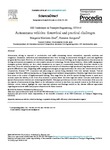Mostrar o rexistro simple do ítem
Autonomous vehicles: theoretical and practical challenges
| dc.contributor.author | Martínez-Díaz, Margarita | |
| dc.contributor.author | Soriguera, Francesc | |
| dc.date.accessioned | 2019-01-30T17:58:35Z | |
| dc.date.available | 2019-01-30T17:58:35Z | |
| dc.date.issued | 2018 | |
| dc.identifier.citation | Martínez-Díaz, M.; Soriguera, F. Autonomous vehicles: theoretical and practical challenges. Transportation Research Procedia 2018, 33, p. 275-282. | es_ES |
| dc.identifier.uri | http://hdl.handle.net/2183/21640 | |
| dc.description | Parte do número especial XIII Conference on Transport Engineering (CIT 2018) | es_ES |
| dc.description.abstract | [Abstract:] Autonomous driving is expected to revolutionize road traffic attenuating current externalities, especially accidents and congestion. Carmakers, researchers and administrations have been working on autonomous driving for years and significant progress has been made. However, the doubts and challenges to overcome are still huge, as the implementation of an autonomous driving environment encompasses not only complex automotive technology, but also human behavior, ethics, traffic management strategies, policies, liability, etc. As a result, carmakers do not expect to commercially launch fully driverless vehicles in the short-term. From the technical perspective, the unequivocal detection of obstacles at high speeds and long distances is one of the greatest difficulties to face. Regarding traffic management strategies, all approaches share the vision that vehicles should behave cooperatively. General V2V cooperation and platooning are options being discussed, both with multiple variants. Various strategies, built from different standpoints, are being designed and validated using simulation. Besides, legal issues have already been arisen in the context of highly-automated driving. They range from the need for special driving licenses to much more intricate topics like liability in the event of an accident or privacy issues. All these legal and ethical concerns could hinder the spread of autonomous vehicles once technologically feasible. This paper provides an overview of the current state of the art in the key aspects of autonomous driving. Based on the information received in situ from top research centers in the field and on a literature review, authors highlight the most important advances and findings reached so far, discuss different approaches regarding autonomous traffic and propose a framework for future research. | es_ES |
| dc.description.sponsorship | Ministerio de Economía y Competitividad; TRA2016-79019-R | es_ES |
| dc.language.iso | eng | es_ES |
| dc.publisher | Elsevier | es_ES |
| dc.relation.uri | https://doi.org/10.1016/j.trpro.2018.10.103 | es_ES |
| dc.rights | Atribución-NoComercial-SinDerivadas 3.0 España | es_ES |
| dc.rights.uri | http://creativecommons.org/licenses/by-nc-nd/3.0/es/ | * |
| dc.subject | Autonomous vehicle | es_ES |
| dc.subject | Vehicle technology | es_ES |
| dc.subject | Cooperative driving | es_ES |
| dc.subject | Traffic efficiency | es_ES |
| dc.subject | Vehicle automation impacts | es_ES |
| dc.title | Autonomous vehicles: theoretical and practical challenges | es_ES |
| dc.type | info:eu-repo/semantics/article | es_ES |
| dc.rights.access | info:eu-repo/semantics/openAccess | es_ES |
| UDC.journalTitle | Transportation Research Procedia | es_ES |
| UDC.volume | 33 | es_ES |
| UDC.startPage | 275 | es_ES |
| UDC.endPage | 282 | es_ES |
| dc.identifier.doi | 10.1016/j.trpro.2018.10.103 | |
| UDC.conferenceTitle | Conference on Transport Engineering, CIT2018 (13.ª. 2018. Gijón) | es_ES |
Ficheiros no ítem
Este ítem aparece na(s) seguinte(s) colección(s)
-
CITEEC-CGM - Artigos [93]






